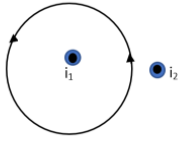
Calculate $\oint{\overrightarrow{B}\cdot \overrightarrow{dl}}$ over following loops. Here the direction in which integration has to be performed has been represented by arrows.
A.

B.

C.


D.




Answer
555.6k+ views
Hint: The current inside the loop is having a direction into We can say that in order to attain stable equilibrium the plane should be in a vertical direction. The integral of the dot product of the magnetic field and the length element over the loops represent that the plane is carrying the current.
Complete answer:
In the first figure we can see that there are two currents. One is outside the loop which will not be producing any kind of magnetic field. Therefore we can neglect it. The other one which is inside the loop is having a current direction going outside the loop. Therefore the magnetic field produced will be anticlockwise in direction. Therefore we can write that,
$\oint{\overrightarrow{B}\cdot \overrightarrow{dl}}={{\mu }_{0}}{{i}_{1}}$
Now for the second figure also the current outside the loop can be neglected. Here the magnetic field produced will be in the anticlockwise direction. As the direction of current is negative, we can write that,
$\oint{\overrightarrow{B}\cdot \overrightarrow{dl}}=-{{\mu }_{0}}{{i}_{2}}$
For the third loop we can see that the current in both the smaller loop is having direction into the sheet. But the current produced is in anticlockwise direction. Therefore we can write that,
$\oint{\overrightarrow{B}\cdot \overrightarrow{dl}}=-{{\mu }_{0}}i-{{\mu }_{0}}i=-2{{\mu }_{0}}i$
For the fourth one we can say the first smaller loop is having a positive value of ${{\mu }_{0}}{{i}_{1}}$ and in the second, third and fourth loop it is negative. Therefore we can write that,
$\oint{\overrightarrow{B}\cdot \overrightarrow{dl}}=-{{\mu }_{0}}i+{{\mu }_{0}}i-{{\mu }_{0}}i-{{\mu }_{0}}i=-2{{\mu }_{0}}i$
Therefore the values for the integral in all the cases have been found.
Note:
The loop has been suspended in a vertical direction. The vertical direction of the loop represents that the plane is normal to the magnetic meridian. Both the magnetic meridian and the plane are in stable equilibrium. Therefore we can say that to attain stable equilibrium the plane should be in a vertical direction.
Complete answer:
In the first figure we can see that there are two currents. One is outside the loop which will not be producing any kind of magnetic field. Therefore we can neglect it. The other one which is inside the loop is having a current direction going outside the loop. Therefore the magnetic field produced will be anticlockwise in direction. Therefore we can write that,
$\oint{\overrightarrow{B}\cdot \overrightarrow{dl}}={{\mu }_{0}}{{i}_{1}}$
Now for the second figure also the current outside the loop can be neglected. Here the magnetic field produced will be in the anticlockwise direction. As the direction of current is negative, we can write that,
$\oint{\overrightarrow{B}\cdot \overrightarrow{dl}}=-{{\mu }_{0}}{{i}_{2}}$
For the third loop we can see that the current in both the smaller loop is having direction into the sheet. But the current produced is in anticlockwise direction. Therefore we can write that,
$\oint{\overrightarrow{B}\cdot \overrightarrow{dl}}=-{{\mu }_{0}}i-{{\mu }_{0}}i=-2{{\mu }_{0}}i$
For the fourth one we can say the first smaller loop is having a positive value of ${{\mu }_{0}}{{i}_{1}}$ and in the second, third and fourth loop it is negative. Therefore we can write that,
$\oint{\overrightarrow{B}\cdot \overrightarrow{dl}}=-{{\mu }_{0}}i+{{\mu }_{0}}i-{{\mu }_{0}}i-{{\mu }_{0}}i=-2{{\mu }_{0}}i$
Therefore the values for the integral in all the cases have been found.
Note:
The loop has been suspended in a vertical direction. The vertical direction of the loop represents that the plane is normal to the magnetic meridian. Both the magnetic meridian and the plane are in stable equilibrium. Therefore we can say that to attain stable equilibrium the plane should be in a vertical direction.
Recently Updated Pages
Master Class 12 Economics: Engaging Questions & Answers for Success

Master Class 12 Maths: Engaging Questions & Answers for Success

Master Class 12 Biology: Engaging Questions & Answers for Success

Master Class 12 Physics: Engaging Questions & Answers for Success

Basicity of sulphurous acid and sulphuric acid are

Master Class 12 Business Studies: Engaging Questions & Answers for Success

Trending doubts
What are the major means of transport Explain each class 12 social science CBSE

Which are the Top 10 Largest Countries of the World?

Draw a labelled sketch of the human eye class 12 physics CBSE

How much time does it take to bleed after eating p class 12 biology CBSE

Explain sex determination in humans with line diag class 12 biology CBSE

Differentiate between homogeneous and heterogeneous class 12 chemistry CBSE




